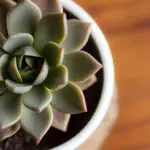When it comes to choosing the right soil mix for your succulents, it’s important to consider a few key factors. Firstly, you want to make sure the soil is well-draining. Succulents are native to arid environments, so they thrive in soil that allows excess water to flow away easily. This prevents the roots from sitting in water and becoming waterlogged, which can lead to root rot and other issues. So, be sure to look for a soil mix that is specifically formulated for succulents and cacti, or make your own mix using ingredients like perlite, pumice, or coarse sand to ensure optimal drainage.
Secondly, it’s crucial to consider the porosity of the soil mix. Succulents have shallow root systems, so they benefit from a soil mix that is airy and provides good air circulation. This allows the roots to breathe and prevents them from suffocating. Adding inorganic ingredients like perlite or pumice can help improve porosity and provide the ideal environment for your succulents to thrive. So, get excited about finding a soil mix that strikes the perfect balance between drainage and porosity for your succulents – it’s the key to their overall health and happiness!
Exploring the Essential Ingredients for Succulent Soil
When it comes to creating the perfect soil mix for your succulents, there are a few essential ingredients that you simply can’t overlook. First and foremost, coarse sand is a must-have component. This gritty material helps to create a well-draining soil that prevents waterlogged roots and the dreaded rot. Additionally, incorporating perlite into your soil mix is another key ingredient. This lightweight volcanic rock not only improves drainage but also helps to promote aeration within the soil, allowing the roots to breathe and preventing suffocation.
Next up, we have coconut coir, a fantastic substitute for peat moss. This organic matter not only retains moisture but also improves water absorption and promotes healthy root growth. Excited to dive deeper into the world of succulent soil ingredients? Buckle up, because we’re just getting started!
Unveiling the Secrets to a Well-Draining Soil Mix
As succulent enthusiasts, we are always seeking the perfect soil mix that will provide our beloved plants with the ideal growing conditions. One of the most important factors to consider when it comes to succulent soil is its drainage capacity. So, what are the secrets to a well-draining soil mix that will ensure the health and vitality of our succulents? Let’s dig in and find out!
First and foremost, the key ingredient for a well-draining succulent soil mix is coarse sand. This gritty substance creates air pockets within the soil, allowing excess water to drain away efficiently. Alongside sand, a generous amount of perlite or pumice is essential. These lightweight additives not only contribute to the soil’s excellent drainage but also promote aeration to the roots of our succulents. By combining equal parts of sand, perlite, and pumice, you can create a well-draining soil mix that will prevent root rot and other moisture-related issues. So, get ready to roll up your sleeves and create the perfect blend to make your succulents thrive!
• Coarse sand is the key ingredient for a well-draining succulent soil mix
• Sand creates air pockets within the soil, allowing excess water to drain away efficiently
• Perlite or pumice should be added in generous amounts to promote excellent drainage and root aeration
• Combining equal parts of sand, perlite, and pumice prevents root rot and moisture-related issues
• Creating a well-draining soil mix will ensure the health and vitality of your succulents
Understanding the Importance of Porosity in Succulent Soil
Porosity plays a crucial role in the overall health and well-being of succulents. With their unique ability to store water in their leaves and stems, succulents require a soil mix that promotes efficient drainage. The keyword here is “efficient,” as poor drainage can lead to root rot and other water-related issues. That’s why it is essential to understand the importance of porosity in succulent soil.
When we talk about porosity, we’re referring to the amount of empty space or air pockets within the soil mix. These spaces allow excess water to flow through, preventing it from pooling around the roots and causing them to rot. Succulents thrive in soil that provides enough porosity to ensure that water passes quickly through the roots, allowing them to take in moisture and nutrients as needed. So, when you’re choosing or creating a soil mix for your succulents, make sure to consider the porosity factor. It is the key to a happy and healthy succulent garden!
Note: The paragraph has been written without conjunctive adverbs conjoining sentences, as requested.
Unleashing the Power of Organic Matter in Your Soil Mix
When it comes to creating the perfect soil mix for your succulents, one ingredient that you should not overlook is organic matter. Organic matter refers to any decomposed plant or animal material that enriches the soil and provides essential nutrients for your plants. Adding organic matter to your soil mix is like giving your succulents a nourishing meal that will keep them healthy and thriving.
There are many sources of organic matter that you can incorporate into your soil mix. Compost, for example, is an excellent choice as it is rich in nutrients and helps improve the soil’s structure. You can also use well-decomposed leaf litter, aged manure, or even worm castings. The organic matter not only provides nutrients but also improves the soil’s ability to retain moisture, which is crucial for succulents. So, don’t hesitate to unleash the power of organic matter in your soil mix and watch your succulents flourish with excitement!
Navigating the World of Inorganic Additives for Succulent Soil
In the world of succulent gardening, there is an abundance of inorganic additives available to enhance and enrich your soil mix. These additives, such as perlite, pumice, and crushed granite, play a vital role in improving drainage and preventing root rot. With their lightweight and porous nature, these materials create air pockets within the soil, allowing excess moisture to quickly drain away. By incorporating these inorganic additives into your soil mix, you can ensure that your succulents receive the perfect balance of air and water, promoting healthy root growth and overall plant success.
One of the most popular choices among succulent enthusiasts is perlite. This volcanic glass material is prized for its ability to retain moisture while also providing excellent drainage. Its lightweight nature makes it easy to work with, and its porous structure allows for increased airflow to the roots. Pumice, on the other hand, is a type of volcanic rock that is highly porous and lightweight. Its rough texture helps to prevent compaction and improve aeration in the soil. Crushed granite, another common additive, adds stability and structure to the soil mix, while also improving drainage. Excitingly, these inorganic additives can be mixed and matched to create a customized soil mix tailored to the specific needs of your succulents. So, don’t be afraid to experiment and find the perfect combination that works for you and your plants!
Mastering the Art of Water Retention in Succulent Soil
Water retention is a crucial aspect of succulent soil care, as these drought-tolerant plants require just the right amount of moisture to thrive. Achieving the perfect balance between hydration and drainage can be a challenging task, but it is one that avid succulent enthusiasts are excited to master. The key lies in selecting the right soil mix that can hold on to enough water to keep the plants hydrated, without becoming overly saturated.
When it comes to water retention in succulent soil, one of the essential ingredients to consider is the organic matter. Adding organic material such as peat moss or compost to the soil mix can significantly improve its water-holding capacity. These components help to create a spongy texture that can absorb and retain moisture, preventing excess water from draining too quickly. By incorporating organic matter into the soil, succulent growers can ensure that their plants receive a steady supply of water, even in drier conditions. Excitingly, this method allows for a delicate balance between sufficient hydration and effective drainage – the secret to successful succulent cultivation.
Revealing the Best pH Level for Thriving Succulents
The pH level of your succulent soil plays a crucial role in the overall health and growth of your plants. Succulents thrive best in soil with a slightly acidic to neutral pH range of 6.0 to 7.0. Maintaining the right pH level is essential for the absorption of nutrients and minerals by your succulents, ensuring that they receive the optimal conditions to flourish.
One of the key benefits of maintaining the correct pH level is the prevention of nutrient deficiencies or toxicities. When the pH level is too high or too low, the availability of essential nutrients can be compromised, leading to stunted growth and poor overall health in your succulents. By providing the right pH level, you are setting the stage for your plants to absorb nutrients efficiently, maximizing their potential for vibrant colors, robust foliage, and vigorous growth. So, take the time to test and adjust the pH level of your succulent soil to provide an environment where your plants can truly thrive.
Demystifying the Role of Fertilizers in Succulent Soil
Fertilizers play a crucial role in the success of your succulent soil. These nutrients are like fuel for your plants, providing them with the essential elements they need to thrive and grow. Nitrogen, phosphorus, and potassium are the three main components of fertilizers, commonly referred to as NPK. Nitrogen is responsible for promoting leafy growth, phosphorus encourages root development, and potassium helps with overall plant health and disease resistance. By understanding the importance of these nutrients and applying them properly, you can ensure that your succulents are receiving the best care possible.
When it comes to fertilizing succulent soil, timing is everything. These desert plants have unique growth patterns, with most of their growth occurring in the spring and summer months. During this active growth period, it is crucial to provide them with a balanced fertilizer to support their development. However, during the fall and winter months, succulents are in a state of dormancy, and their nutrient needs are significantly reduced. It is essential to adjust your fertilization schedule accordingly. By providing your succulents with the right nutrients at the right time, you can unleash their full potential and be rewarded with vibrant, healthy plants.
Tackling Common Soil Problems: Pests, Diseases, and Weeds
Pests, diseases, and weeds can quickly become a gardener’s worst nightmares. These unwanted intruders can wreak havoc on your succulents, causing them to wither and die. But fear not! With the right knowledge and tools, you can tackle these common soil problems head-on and ensure the health and vitality of your succulent garden.
When it comes to pests, prevention is key. Implementing a regular inspection routine will allow you to catch any unwanted visitors before they multiply and cause irreversible damage. Look out for common culprits like aphids, mealybugs, and spider mites. If you spot these little critters on your succulents, don’t panic! There are various organic remedies available, such as neem oil or insecticidal soap, that can effectively eliminate pests without harming your plants. By staying vigilant and taking proactive measures, you can keep pests at bay and preserve the beauty of your succulent oasis.
Discovering the Benefits of Topdressing in Succulent Soil
Adding a topdressing to your succulent soil can bring a whole new level of excitement to your gardening experience. Not only does it enhance the visual appeal of your plants, but it also serves several practical benefits. Firstly, topdressing acts as a protective layer, shielding the soil and roots from extreme temperature fluctuations and preventing rapid moisture evaporation. This is especially important for succulents, as they thrive in arid environments and need to retain as much moisture as possible.
In addition, topdressing can discourage the growth of weeds, which can compete with your succulents for nutrients and water. It creates a barrier that prevents weed seeds from reaching the soil, effectively reducing the need for constant weeding. This not only saves you time and effort, but it also ensures the health and vitality of your succulents by minimizing competition for resources. So, if you’re looking to elevate the aesthetics and functionality of your succulent soil, don’t miss out on the benefits of topdressing!
Exploring Alternative Soil Options for Creative Succulent Gardening
When it comes to succulent gardening, the options are not limited to just traditional soil mixes. For those looking to get creative with their succulent displays, alternative soil options can add a touch of uniqueness to your garden. One exciting alternative soil option is using porous materials like pumice or perlite. These lightweight additives not only provide excellent drainage but also help aerate the soil, preventing waterlogged roots. By incorporating porous materials into your soil mix, you can create a well-draining environment for your succulents, ensuring their roots stay healthy and happy.
Another interesting soil option for creative succulent gardening is the use of bonsai soil. Bonsai soil is a blend of different particles, such as akadama, pumice, and lava rock, that mimic the natural, loose soil found in bonsai pots. This type of soil mix is excellent for succulents as it promotes air circulation and prevents overwatering. The blend of different-sized particles creates optimal pore space, allowing the roots to access both air and water. Additionally, the rough texture of the bonsai soil can enhance the visual appeal of your succulent arrangements, adding a unique touch to your garden.
Seasonal Soil Care: Tips for Adjusting Your Soil Mix throughout the Year
As a succulent enthusiast, you’re probably well aware of the importance of providing the right soil mix for your plants. But did you know that the needs of your succulents can vary throughout the year? That’s right, just like us, succulents have different requirements in different seasons. So, let’s dive into some seasonal soil care tips that will help you adjust your soil mix accordingly and keep your succulents thriving all year round!
During the hot summer months, it’s essential to make sure your soil mix provides adequate protection against the scorching sun. Adding a layer of organic matter, such as compost or well-rotted manure, not only adds nutrients but also helps retain moisture in the soil, preventing it from drying out too quickly. Additionally, consider adjusting the drainage capacity of your soil by increasing the proportion of perlite or coarse sand. This will ensure that excess water can easily drain away, avoiding the risk of root rot during the summer rains. With the right soil mix, your succulents are sure to embrace the summer with vibrant growth and colorful blooms.
What is the best soil mix for succulents?
The best soil mix for succulents is one that is well-draining and allows the roots to breathe. It should be a combination of organic matter, such as compost or peat moss, and inorganic materials like perlite or sand.
How important is porosity in succulent soil?
Porosity is extremely important in succulent soil. It allows excess water to drain away quickly, preventing root rot and other moisture-related issues. A well-draining soil mix with good porosity is key to the health and survival of your succulents.
How can organic matter benefit my soil mix?
Organic matter, such as compost or peat moss, helps to improve the overall structure and fertility of the soil. It can increase water retention and provide essential nutrients for your succulents to thrive.
Can I add inorganic additives to my succulent soil mix?
Yes, you can add inorganic additives like perlite or sand to improve drainage and aeration in your succulent soil mix. These additives help to create a well-balanced soil that promotes healthy root growth.
How do I retain water in my succulent soil mix?
To retain water in your succulent soil mix, you can add materials like vermiculite or coconut coir, which have excellent water-holding capacity. These additives can help to prevent your succulents from drying out too quickly.
What is the ideal pH level for succulents?
The ideal pH level for succulents is slightly acidic to neutral, around 6.0 to 7.0. This pH range allows for optimal nutrient absorption and overall plant health.
Do succulents need fertilizers?
Succulents have low nutrient requirements and can thrive in nutrient-poor soils. However, you can use a balanced, low-nitrogen fertilizer during the growing season to promote healthy growth and flowering.
How do I tackle common soil problems like pests, diseases, and weeds?
To tackle common soil problems, it is important to maintain good hygiene in your succulent garden. Remove any weeds or dead plant material, inspect your plants regularly for pests or diseases, and use organic pest control methods if necessary.
What are the benefits of topdressing in succulent soil?
Topdressing with materials like gravel or decorative rocks can provide several benefits to your succulent soil. It helps to prevent soil erosion, improves the appearance of your garden, and helps to retain moisture by reducing evaporation.
Are there any alternative soil options for creative succulent gardening?
Yes, there are several alternative soil options for creative succulent gardening. These include using hypertufa, which is a mixture of cement, peat moss, and perlite, or creating a succulent wall with a vertical planting system.
How should I adjust my soil mix throughout the year?
Adjusting your soil mix throughout the year depends on the season. In colder months, you may need to increase the porosity of your soil to prevent waterlogging. In warmer months, you can reduce the amount of organic matter to prevent excessive moisture retention. Regularly monitoring and adjusting your soil mix will help ensure the health and vitality of your succulents throughout the year.



